
Increase Engagement and Sell More Courses with a Content Structure Strategy
It’s time to build out your course. You’ve purchased and installed LearnDash and have all your content, but there is a critical decision to make before getting started.
How should you structure your content to maximize learner engagement and course sales?
LearnDash, like all top Learning Management Systems, has a content hierarchy. So rather than having a flat learning experience where you move from one lesson to another, you can group content into sections, lessons, and lesson topics.
The structure of your content plays a significant role in the experience and marketability of your courses– it’s worth doing right.
This article will cover the LearnDash content hierarchy, the psychological principles influencing learner engagement and sales, and how to identify the right structure for your course content.
Let’s start by discussing the LearnDash content hierarchy.
LearnDash Content Hierarchy
As previously discussed, LearnDash segments content into sections, lessons, topics, and quizzes. This segmentation allows you to group your content into themes and smaller, more manageable bites. Below you’ll see a screenshot representing each segment.
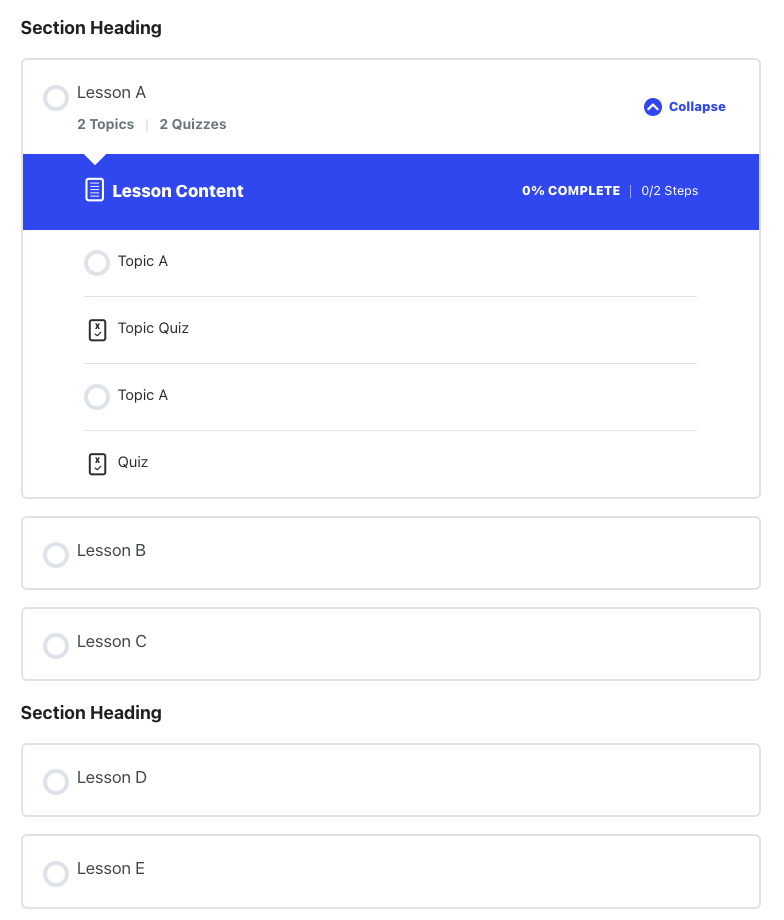
Let’s cover each segment in more detail.
Lessons
Lessons are the highest content in the LearnDash hierarchy. When learners start a course, their first action is moving into the first lesson. They then work through each subsequent lesson until the course is complete.
If you have a simple course, you might only have lessons.
Sections
Sections are simply groups of lessons. In short, adding a section allows you to split lessons visually with a heading in-between. There are advantages to this which influence both sales and engagement, which we’ll discuss below.
Topics
Topics are children of lessons. They behave much like lessons in terms of capability but are only accessible by first navigating into the parent lesson. Topics allow you to split longer lessons into more manageable, multi-step bites, which can increase engagement.
Quizzes
Quizzes can appear in several places within the LearnDash content hierarchy. For example, they can be at the top level alongside lessons, be a child of a lesson (similar to topics,) or be a child of a topic.
The only factor to note is quizzes at the lesson level can only occur at the end of a course. Therefore, if you want a quiz to occur before or after a lesson, it must be a child quiz.
Assignments
Assignments are instances where users must submit a file or answer an open-ended question to proceed. That file can be auto-approved or manually approved. Lessons and topics can have assignments. Segments cannot, however, because they don’t have a dedicated page. Instead, they’re just a visual break between lessons.
Now that you understand the LearnDash content structure let’s talk about the psychological factors influencing how best to map your content into this hierarchy.
Design Psychology
The ideal course content hierarchy is influenced by psychology. Upon seeing your course outline, learners and prospects will make assumptions and judgments about the value and complexity of your course.
They’re less likely to buy if the course structure doesn’t facilitate a straightforward assessment of course value. Similarly, they’re unlikely to buy if the format makes the course feel overwhelming or complex.
From an existing learner’s standpoint, the course structure directly impacts how engaging the course is and can be the difference between a course completion or abandonment.
There are three primary psychological principles at play:
- Chunking
- Progressive Disclosure
- Gamification
Chunking
It’s easier to process and consume large amounts of information when grouped into common themes. For example, if I asked you to remember the following list, you would likely struggle:
- Carrots
- Hamburger
- Oranges
- Brocolli
- Watermelon
- Celery
- Strawberries
- Pork chops
- Bacon
However, if I break it into groups, it’s much more manageable.
Vegetables
- Carrots
- Brocolli
- Celery
Proteins
- Hamburger
- Pork chops
- Bacon
Fruits
- Oranges
- Watermelon
- Strawberries
Sections and topics allow you to group content into themes. Like the grouping above, this reduces the cognitive load to process the themes and concepts taught in the course. In turn, the course is more manageable for existing learners, and potential buyers better understand the course value.
Consider these two examples, lesson with and without the segments:
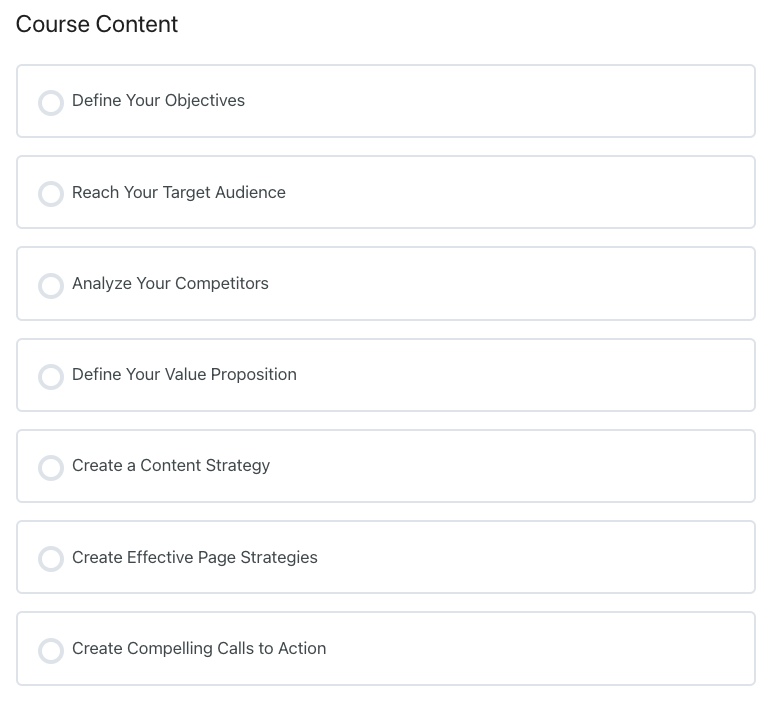
and
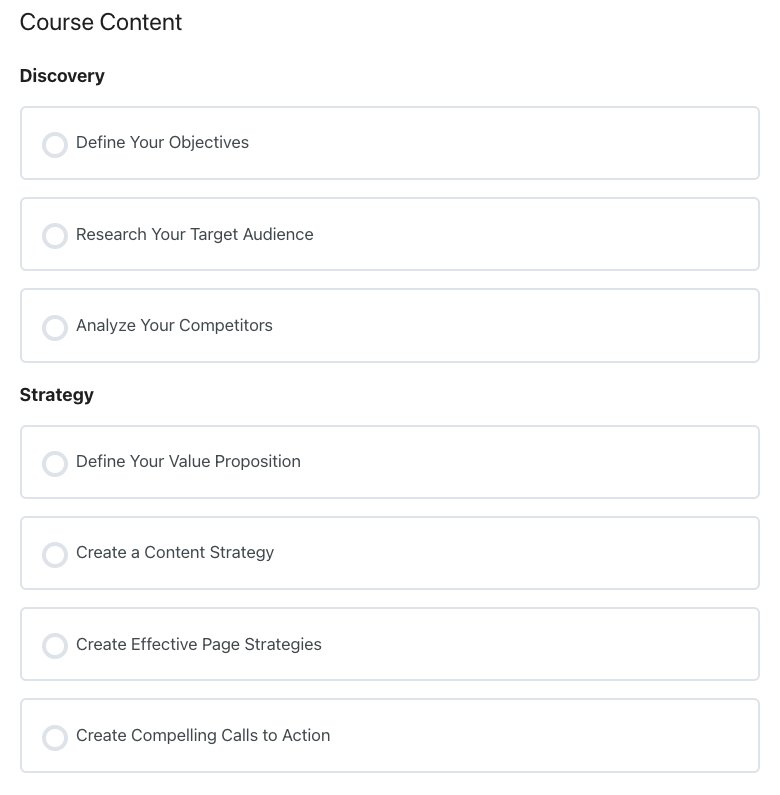
Which is easier to process and understand? The second example.
A related and equally important psychological principle is “Progressive Disclosure,” let’s dive in.
Progressive Disclosure
Progressive disclosure is a concept where it’s easier to process information when you are exposed to high-level information initially and can opt to see more detail when desired.
An example would be an archive of blog posts on your website. You typically wouldn’t display each entire post on a single page. Instead, you have the most pertinent information, like the title and short description, with a link to show the full post.
Using summaries instead of the entire post makes it easier to identify all the topics discussed on the blog, and decide which to interact with and see more.

You can use progressive disclosure in your course through topics and child quizzes. Your lessons become the highest-level concepts, and learners can expand the lesson to see more detailed concepts.
Let’s expand on our previous example above:
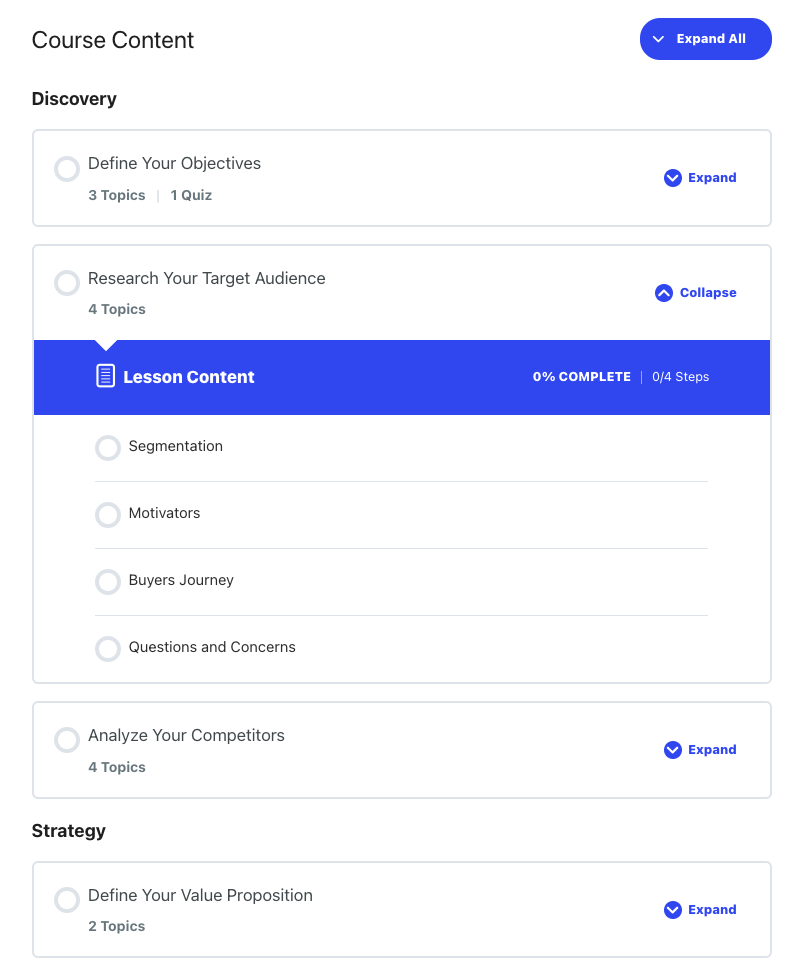
Like chunking, it’s easier for prospects to comprehend the core concepts taught in your course, increasing the likelihood of buying. In addition, for existing learners, the course feels less overwhelming as there are fewer steps to focus on at a given time.
Gamification
You can use two gamification principles to shape your course structure, “Investment Loops” and “Appropriate Achievements.”
Making progress within a course (like completing a section, lesson, topic, or quiz) activates our reward centers. We’re making progress toward a goal, and it feels good. The more you can trigger this positive feeling, the more motivated learners will be.
Triggering our reward center is a balance. For example, the Appropriate Achievements principle states that to trigger reward feelings, the next step must be difficult enough to feel challenging but not so difficult it feels unobtainable.
In execution, each step of your course should be just long and complex enough to challenge the learner but short enough to feel immediately achievable. So rather than an extended lesson that covers 3 – 5 complex concepts, you have a single lesson with 3 – 5 topics.
Now you have a handful of steps that will take 3 – 5 minutes instead of one that will take 15 – 20. As a result, learners can tackle one or two quickly, which feels rewarding, vs. needing more time or energy to complete one more significant step.
This approach also triggers an “Investment Loop,” where you feel fulfilled for completing a step but still want more. As a result, learners are more likely to complete three 5min steps than one 15min one.
Pro tip! Visually indicating how long a step will take is a great way to increase learner engagement. Visual Customizer for LearnDash allows you to do so in minutes!
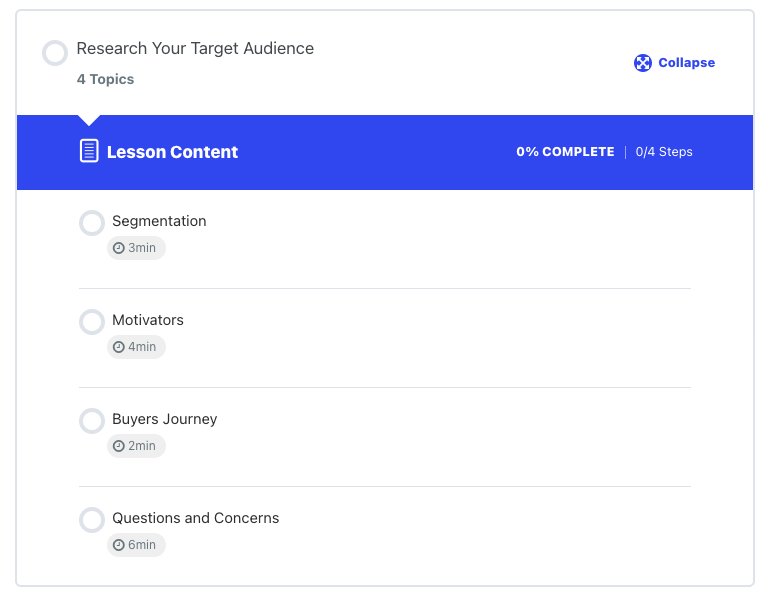
Now that you understand the psychology behind segmenting your content into sections, lessons, topics, and quizzes, let’s cover how to identify the optimal course content structure.
Creating Your Content Outline
Before you populate any content in LearnDash, I recommend creating a “content outline,” a collection of bulleted lists that identify the sections, lessons, topics, and quizzes.
Broad Themes
First, start by creating a list of the major themes or concepts the course will teach learners. If you end up with more than 10, I’d recommend seeing if you could combine them into a more generalized theme.
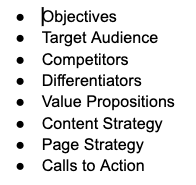
Primary and Sub Concepts
Then, within each of the 3 – 7 broad themes, create a nested list of the 3 – 7 concepts within those themes.
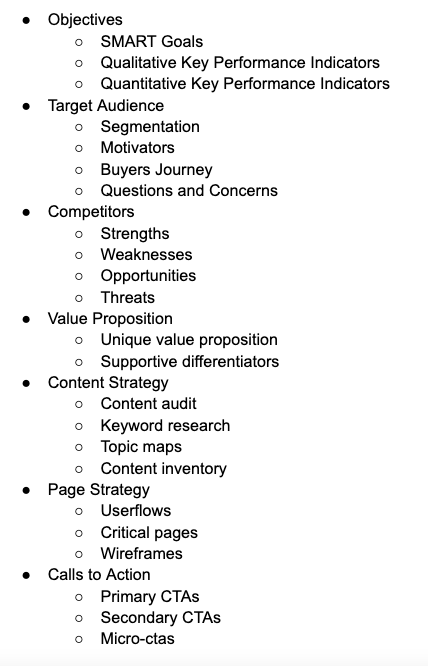
Now evaluate each idea and assess how long it would take to fully explain the concept to someone who knew nothing about it. If the answer is more than 5 – 7 minutes, then you need another layer of hierarchy. Split your 3 – 7 sub-concepts into another 3 – 7 sub-sections.
If you need more than seven sub-sub sections or find it would still take longer than 5minutes to explain, consider splitting this one course into several focused courses.
Sections or Topics
Now you have between two and three layers in your content hierarchy. You’ll use sections, lessons, and topics if you have three layers.
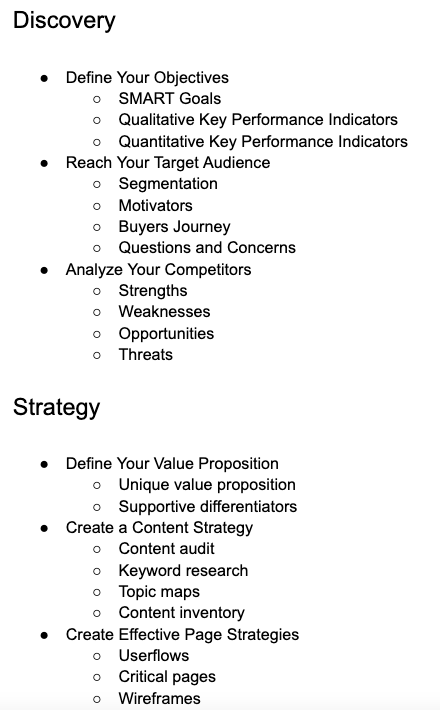
You must choose topics or sections for your hierarchy if you only have two.
I’d look at it like this: your lessons are like your book table of contents.
The table of contents is a significant factor in the decision to purchase a book. Similarly, users will scan your list of lessons to decide if they want to buy. So there is some advantage to having more lessons provided you can keep it from overwhelming. For example, 15 lessons split into three sections will better “sell” your course than three lessons with five topics each (because more information is hidden.)
You now have a complete strategy to populate and segment your content into LearnDash!

Ross Johnson
@LearnDashLMS






